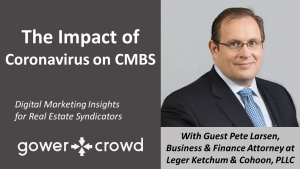FREE TRAINING
What is Real Estate Crowdfunding?
Learn how to build wealth and earn passive income in real estate while someone else does all the work.
Spencer Levy, Senior Economic Advisor for CBRE and Chairman of Americas Research
A Deep Dive Into Cap Rates
 Today's Guest Spencer Levy
Today's Guest Spencer Levy
Today, I am going back to our regular programming with a conversation recorded right at the very beginning of the coronavirus crisis.
When I spoke to Spencer, we'd all just been sent home to work and our conversation, though, tinged with what was going on, had not become immersed yet in the depths of the lockdowns we are today enduring. What you're going to hear today is an analysis of cap rates, what they are, why they are misunderstood and how they impact commercial real estate from one of the foremost analytical minds in the country.
This information will be of significant value to you as you start to navigate through the current crisis because Spencer's perspective challenges the usual understanding of cap rates, and his insights will take you deeper into the metric than you've likely ever been before. Perfect, in fact, for seeing the world as it has evolved and continues to evolve through this crisis and through a differently-tinted lens.
What You're Going to Learn
- The Authoritative Definition of Cap Rates
- Different Methods of Calculating a Cap Rate
- How Cap Rates Are Used in Real Estate
- Understanding the Key Factors that Impact Cap Rate
- Cap Rates and Associated Risks for Multifamily Real Estate
- Variables for Cap Rates in Different Markets
- Cap Rate Expectations in Large Markets Vs. Small Markets
- Cap Rate Expectations in Large Markets Vs. Small Markets
- The Correlation Between Cap Rate and IRR
- And much more!
Related to this Episode - Cap Rates: Ultimate Real Estate Investing Guide
Listen To or Watch the Full Podcast Here
Show Highlights
Different Methods of Calculating a Cap Rate
ADAM GOWER: So, how do you calculate the cap rate? What is the calculation?
SPENCER LEVY: Well, the cap rate, it can be calculated on either a pro forma forward basis or looking back basis. And depending upon who you are, you have to calculate it
One of those two ways, I would say that most people, when they're marketing an asset, calculate a cap rate on the forward, which is based upon the income you expect to receive in the next year. Though, some people are required to look backwards, if you're looking to appraise it or you're a lender and you're looking for other metrics of stabilized cap rate. Looking at the forward and the backwards cap rate. So, on a forward cap rate basis, let's assume for the moment that you have a stabilized asset that generates $1 a year of net operating income.
Now net operating income, not to make this overly complicated, is basically what's left after you've paid for expenses in the building. You've gotten your rent, you pay your expenses in the building, you've got your net operating income roughly. And that then, you need to put through your capital structure and figure out what your free cash flow might be. But for purposes of cap rate, you don't do it on free cash flow, you do it on net operating income, which is before your capital structure. So what your cap rate would be, is the percentage of yield based upon the amount of money you've invested in the building, divided by your NOI, or rather the reverse of that, your NOI, divided by the amount you've invested in the building.
So in that building, if you paid ten bucks and you're getting $1 of NOI, you have a 10 cap. If you take that same building and you get 50 cents a year, you get a 5 cap. And the reason is, is that a cap rate is the inverse of a multiple.
Many people call a cap rate an inverse multiple. At least I do, because that's what it is. So if you hear a 20 times multiple, it's the equivalent of a five cap rate.
How Cap Rates Are Used in Real Estate
ADAM GOWER: So now you've described a couple of characteristics of the cap rate. How is it used, before we got into your research? And how is it used in the commercial real estate industry?
SPENCER LEVY: Well, notwithstanding the fact that our cap rate survey is our most, CBRE's most popular research piece every year, bar none, because it's a tremendous resource to look across multiple asset types, multiple markets quickly.
Now I'm going to go full circle. We use cap rates too much. And why is that? Because they tell you something, but they don't tell you nearly enough. They give you a very good snapshot, but they don't go into the nuances that I've described a moment ago, as it relates to things such as, what is your expenses you're going to have to spend your capital expenditures to stabilize your building to get to a stabilized yield. I prefer looking at it on a discounted cash flow analysis, perhaps better than looking at it on a cap rate basis. But nevertheless, it's a very good quick snapshot of where values are, in the market, and you can do it on a relative "apples to apples" basis across market and across asset types.
ADAM GOWER: Right. OK. So you talked about discounted cash flow, but I want to kind of just continue on this, how is the cap rate used? There's two ways that it's used. One is to look at, forward looking in terms of value, or, so now you said it's not yield. It's not yield. But at the end of the day, you are looking at a step projecting when your building is going to be stabilized and what kind of returns you're going to get at that time. So that's one way. But it's also used to calculate value, isn't it? In what way is it used for that when you're looking at a property?
SPENCER LEVY: Sure. So, let's assume that you have a property that is generating a thousand dollars a year in net operating income and the property next door,
Let's say it's an industrial asset because an industrial asset, they typically have lower cap rates today than many other asset classes because they're so popular. Let's assume that the asset next door traded at a five cap. You say, oh, well, I'm going to put a five percent yield on my thousand dollars and whatever a thousand times twenty is, which is twenty thousand dollars, that must be the value of my building. If my building, it generated ten thousand dollars of NOI,
It would be a two hundred thousand dollar building if the building next door is a perfect comp. If it's not a perfect comp, then you adjust the cap rate. Maybe your building isn't as well located. Maybe it needs more Cap X. Maybe your lease of your tenant doesn't run as long. Maybe there are other things. It doesn't have as good a parking. But maybe it's a superior asset. Maybe it's the best industrial building, brand spanking new with perfect credit tenant. They pre-paid their 10 years of rents, in advance,
And they're going to cut you a check. You'd get a lower cap rate.
FOR REAL ESTATE DEVELOPERS
THE WHITE BOARD WORKSHOP
Learn the exact system best of class sponsors use to raise money online.
Variables for Cap Rates in Different Markets
ADAM GOWER: How do cap rates vary: office, class-A, and multifamily class-A. If those are the same, doesn't that disprove your theory? And if they are different, in what way are they different?
SPENCER LEVY: Well, professor. I hate to disabuse you of this notion.
ADAM GOWER: Please do.
SPENCER LEVY: But if you take a class-A office asset and a class-A multifamily asset in New York, in San Francisco, in Los Angeles, in Washington, D.C., in major markets, you're going to see a very similar cap rate for class-A office in those major markets, as you will, for class-A multi-family. Very similar. Not exactly the same. There's nuance. They're similar. Where you're not going to see the same cap rate, is if you go to a smaller market. If you go to a smaller market, like a Baltimore, like a Cleveland, like a Richmond, Virginia, you're going to see an enormous spread differential between multifamily and office. And that spread differential could be 300-400 basis points, meaning that you could have the best multifamily asset in Baltimore, might trade at sub 5 cap. But, the best office building in Baltimore might trade at a 7 cap. So that's 200 basis points. And if you go into a market like a Cleveland or even smaller like a Richmond, it might be an 8 cap, it might be a 9 cap on the office buildings. But the multifamily is still only going to be around a 5 and 1/2 cap, and so that delta just widens as you get to these smaller markets.
So don't think that multifamily and office trade the same just because they do in New York, San Francisco and Los Angeles.
Cap Rate Expectations in Large Markets Vs. Small Markets
SPENCER LEVY: as I mentioned before, the reason why multi-family has such low cap rates is largely due to its liquidity. It has tremendous liquidity due to the debt capital markets.
But when you go to these major metros, the liquidity of office assets is not the same, but it approaches the level of liquidity of these multifamily assets, number one, number two, I got bad news for most markets in America. I play a little magic trick.
I'm gonna play of a magic trick right here with you on the phone here, if I can Adam. I'm not even sure where you're sitting,
But I'm going to guess the class-A rent, in your market, is $21.50 for office.
And why am I guessing that? Because that's the class-A, office rent in 90 percent of the office markets in America. You know where it's not $21.50? In New York, San Francisco, Boston, Washington, D.C. I go right to analysts, the major markets. And then there are some emerging markets that have growth as well, like Austin, Texas, like Denver. I go down these lists as well. So a cap rate, you have to remember. What did I say what a cap rate was? It is the combination of the cost of capital and growth expectations. And these major markets have actual growth expectations on class-A rent that these smaller markets typically do not.
How Will Cap Rates Vary Through the Life of a Real Estate Cycle
ADAM GOWER: this latest report goes all the way back. He said tongue in cheek to 2013. But we all know that the world didn't start in 2013. It actually restarted at around, what, actually it was probably around then. But the last downturn was 2007. So, my question to you is, we're seeing some tumult now and it's hard to imagine that it's going to affect cap rates today. Right. But it certainly could have some impact going forwards because of exactly those expectations that you have, right? Growth expectations.
SPENCER LEVY: Yeah.
ADAM GOWER: But how do cap rates vary? And I have another question to dovetail into this, in a minute. How do cap rates vary through the life of the real estate cycle?
SPENCER LEVY: Sure. So historically, and you can see the charts on this.
They go way up during a downturn and then they creep back down and they go back up again. They porpoise right? Up and down, up and down, up and down.
Now, one of the material changes that happened during the last cycle is a couple of things. Number one, when you got to the peak of prior cycles, you typically saw secondary market cap rates and primary market cap rates converge. At the peak of this cycle, secondary market cap rates are still very wide, primary market cap rates, except in multifamily and industrial, where they're right on top of each other. In office and in retail and in hotels, its still very wide, I think. And I say this not to disparage secondary markets, but the market is showing more discipline this time in going into some of these markets that may not have the same growth expectations. They're not chasing yield. In fact, one of my clients uses the term "a value trap". What is a value trap? You go into a market that has a high yield, "ah, I've got a great return". Well, what if NOI goes down? What if liquidity dries up? Well, that's what a value trap is. And so, you're correct. Historically you've seen this porpoising, and I'm using my hand as a prop here. So change number one is that the conversions of secondary and primary has stayed wide in office, retail and hotels where typically was convergence. That's point A. Point B is, the top of the chart now, I think, is permanently lower. So let's assume that, there are two basic concepts in economics that really drive modeling. One is, reversion to the mean and the other is, the scariest 4 words in Finance, "this time is different". Otherwise known as a secular shift.
And so, the reversion to the mean argument has consistently failed over the last 10 years because there has been a secular shift in markets like San Francisco and Boston and Austin, Texas. Why do I mention those three markets? Because if they go back to their historic means for cap rates and for rents, they're going to fall off the planet in terms of value. But that hasn't happened. And what is the secular shift that's occurred? Secular shift A is demographic where we're seeing more young, talented people move to these markets. We're also seeing large employers move to these markets. We're also seeing the industries in which they work, particularly tech and its subsidiaries, like biotech, becoming such a big part of the market, that they have outsized demand, which is stripping away demand from markets that had, "old school demand". There's "new school demand" and there's "old school demand". New school demand is what we would call the TAMI industries. Tech, information, media. Old school demand, or the old school industries, which is law, accounting, finance and government. And markets that have the disproportionate number of old school have not shown the same level of rent growth as those that showed new school types of tenants. And when I say markets, I also mean submarkets. So an example of that would be, the delta between, the difference between midtown, and midtown south. Midtown south used to be the sleepy little backwater that had rents way below midtown. Guess what? Rents in midtown south are now higher than the rents in midtown because of the tech explosion.
The Correlation Between Cap Rate and IRR
ADAM GOWER: And how does cap rate, again, during a cycle, how does it correlate to IRR, to the Internal Rate of Return?
SPENCER LEVY: Sure. So an Internal Rate of Return is the net present value if the discount rate was zero.
ADAM GOWER: Right.
SPENCER LEVY: So that is what the math of a IRR is, you know.
ADAM GOWER: Right. Which is how everybody speaks, right?
SPENCER LEVY: Right. So that's that's the math of it all. OK. Now that you know the math. The IRR is really, the unlevered IRR is, I think, a much better metric of value than is a cap rate, because a cap rate is very static. It's based upon either one year forward or one year back or stabilised. Right/ I think that the unlevered IRR is a much better metric of value. It is used by most people in the finance field, certainly every lender, every sophisticated investor, because it talks about what is the returns going to be over your hold period, not just year zero.
ADAM GOWER: Is the unlevered IRR the average cap rate over a period of investment?
SPENCER LEVY: If you were to take the unlevered IRR. I'll say the unlevered IRR were 10. The answer is no. And I'll tell you why it's not, because you also, in a cash flow stream, if you had an infinite cash flow stream, yes, it would be.
But you don't have an infinite cash flow stream. What you have is an exit cap rate. And that exit cap rate has to be calculated based on something. And so you're getting that cash back. So ultimately, they're not exactly the same. They're similar, but not exactly the same.
FOR REAL ESTATE DEVELOPERS
THE WHITE BOARD WORKSHOP
Learn the exact system best of class sponsors use to raise money online.
Related to this episode:














